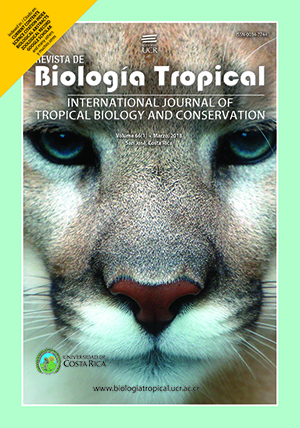Abstract
Trail-following pheromone is one of the most important semiochemical in termites. This pheromone is responsible for the recruitment of individuals from the colony to perform different tasks. The aim of this work was to isolate and identify the trail-following pheromone of Microcerotermes exiguus (Isoptera: Termitidae), a typical termite from the Neotropic, that is considered pest in some crops. Subterranean nest of M. exiguus were collected with a shovel in Caracas, Venezuela in 2010. Different chemical micro-reactions combined with chromatographic analysis of solvent extracts, as well as solid phase microextraction analyses (SPME) were applied to termite sternal glands; besides, some behavioral biossays were undertaken. A peak in the chromatograms from extracts (retention index: 1483), presented a fragmentation pattern with m/z ions: 41; 55; 67; 79; 91; 105; 119; 135; 142; 180, this result alongside behavioral assays allowed us to conclude that (3Z,6Z,8E)-dodeca-3,6,8-trien-1-ol (DTOH) acts as the main component of the trail following pheromone. The estimated optimum concentration for termite recruitment and orientation was around 1 pg/cm, being statistically comparable to the value on trails marked with whole body extracts at concentration of 1 worker/cm. The period of time that this compound takes to recruit other colony members is 13.67 ± 5.76 s and lasts up to two hours. Both analytical and behavioral results provided better understanding on the chemical communication of M. exiguus. This information could be used for the future development of newer pest control methods.
References
Abadía, J. C., Arcila, A. M., & Chacón, P. (2013). Incidencia y distribución de termitas (Isoptera) en cultivos de cítricos de la costa Caribe de Colombia. Revista Colombiana de Entomología, 39(1), 1-8.
Batalha, L. S., Da Silva Filho, D. F., & Martius, C. (1995). Using termite nests as a source of organic matter in agrosilvicultural production systems in Amazonia. Scientia Agricola, 52(2), 318-325.
Bordereau, C., & Pasteels, J. M. (2010). Pheromones and chemical ecology of dispersal and foraging in termites. In: Bignell, D. E., Roisin, Y., Lo, N. ( eds.). Biology of Termites: A Modern Synthesis. (pp. 279-320). Dordrecht, Netherlands: Springer.
Boulogne, I., Constantino, R., Amusant, N., Falkowski, M., Rodrigues, A. M., & Houël, E. (2017) Ecology of termites from the genus Nasutitermes (Termitidae: Nasutitermitinae) and potential for science-based development of sustainable pest management programs. Journal of Pest Science, 90(1), 19-37.
Cristaldo, P. F., De Souza, O., Krasulová, J., Jirošová, A., Kutalová, K., Lima, E. R., & Sillam-Dussès, D. (2014). Mutual use of trail-following chemical cues by a termite host and its inquiline. PLoS One, 9(1), e85315.
Du, T. Y., Lo, C. T., Tang, M. L., & Liang, M. Y. C. (1982). On the trail-following substance of black-winged subterranean termite (Odontotermes formosanus Shiraki). Acta Entomologica Sinica, 25, 172-177.
Ferreira de Souza, J., Vieira de Oliveira, A., Maciel, D., Da Silva, D., Paes, M. A., & Correia, A. (2009). Termitofauna em cana de açucar e fragmento de mata atlántica em Igarassu, Pernambuco. From: http://www.eventosufrpe.com.br /jepex2009/cd/resumos /R0323-1.pdf
Howse, P. E., Stevens, J. M., & Jones, G. A. (1998). Insect pheromones and their use in pest management. London, England: Chapman & Hall.
Kaissling, K. E. (2014). Pheromone Reception in Insects. In: Mucignat-Caretta C. (Ed.) Neurobiology of Chemical Communication. Boca Ratón, FL: CRC Press.
Martins, A., & DeSouza, O. (2008) Nestmate recognition in Cornitermes cumulans Termites (Insecta: Isoptera). Sociobiology, 51, 1-9.
Matsumura, F., Coppel, H. C., & Tai, A. (1968). Isolation and identification of termite trail-following pheromone. Nature, 219, 963-964.
Millar, J. G. H. & Haynes, K. (1998). Methods in chemical ecology Volume 1: Chemical Methods. New York: Springer-Verlag.
Miranda, C., Vasconcellos, A., & Bandeira, A. (2004). Termites in sugar cane in Northeast Brazil: Ecological aspects and pest status. Neotropical Entomology, 33(2), 237-241.
Peppuy, A., Robert, A., Semon, E., Ginies, C., Lettere, M., Bonnard, O., & Bordereau, C. (2001). (Z)-dodec-3-en-1-ol, a novel termite trail pheromone identified after solid phase microextraction from Macrotermes annandalei. Journal of Insect Physiology, 47(4-5), 445-453.
Saran, K., Millar, J., & Rust, M. (2007). Role of (3Z,6Z,8E)-dodecatrien-1-ol in trail following, feeding, and mating behavior of Reticulitermes hesperus. Journal of Chemical Ecology, 33(2), 369-389.
Schulz, S. (2005). The chemistry of pheromones and others semiochemicals II. Berlin: Springer-Verlag.
Sillam-Dussès, D., Kalinová, B., Jiroš, P., Březinová, A., Cvačka, J., Hanus, R., Šobotníka, J., Bordereau, C., & Valterová, I. (2009). Identification by GC-EAD of the two component trail-following pheromone of Prorhinotermes simplex (Isoptera, Rhinotermitidae, Prorhinotermitinae). Journal of Insect Physiology, 55, 751-757.
Sillam-Dussès, D., Sémon, E., Lacey, M. J., Robert, A., Lenz, M., & Bordereau, C. (2007). Trail-following pheromones in basal termites, with special reference to Mastotermes darwiniensis. Journal of Chemical Ecology, 33(10), 1960-1977.
Sillam-Dussès, D., Sémon, E., Robert, A., Cancello, E., Lenz, M., Valterova, I., & Bordereau, C. (2010). Identification of multicomponent trail pheromones in the most evolutionarily derived termites, the Nasutitermitinae (Termitidae). Biological Journal of the Linnean Society, 99(1), 20-27.
Tai, A., Matsumura, F., & Coppel, H. C. (1971). Synthetic analogues of the termite trail-following pheromones, structure and biological activity. Journal of Insect Physiology, 17, 181-188.
Tokoro, M., Takahashi, M., Tsunoda, K., Yamaoka, R., & Hayashiya, K. (1991). Isolation and identification of the trail pheromone of the subterranean termite Reticulitermes speratus (Kolbe) (Isoptera: Rhinotermitidae). Wood Research, 78, 1-14.
Tokoro, M., Takahashi, M., & Yamaoka, R. (1992). (Z,E,E)-Dodecatrien-1-ol: a minor component of trail pheromone of termite Coptotermes formosanus Shiraki. Journal of Chemical Ecology, 20, 199-215.
Verma, M., Sharma, S., & Prasad, R. (2009) Biological alternatives for termite control: A review. International Biodeterioration and Biodegradation, 63, 959-972.
Wobst, B., Farine, J. P., Ginies, C., Sémon, E., Robert, A., Bonnard, O., Connétable, S., & Bordereau, C. (1999). (Z,Z,E)-3,6,8-Dodecatrien-1-ol, a major component of trail-following pheromone in two sympatric termite species Reticulitermes lucifugus grassei and R. santonensis. Journal of Chemical Ecology, 25(6), 1305-1318.
##plugins.facebook.comentarios##

This work is licensed under a Creative Commons Attribution 4.0 International License.
Copyright (c) 2018 Revista de Biología Tropical


